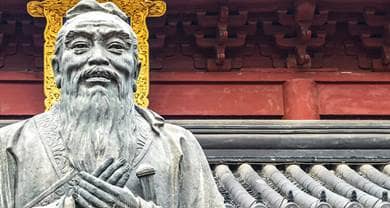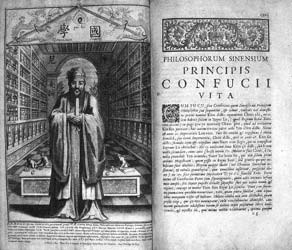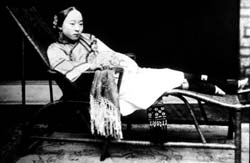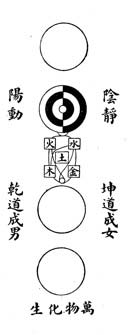- Trending:
- Pope Leo Xiv
- |
- Israel
- |
- Trump
- |
- Social Justice
- |
- Peace
- |
- Love

RELIGION LIBRARY
Confucianism
Gender and Sexuality
Women were at the bottom of the Confucian hierarchy. Exemplary behavior and uncomplaining obedience was expected of them. By custom, aristocratic men and women lived separately. Men had multiple wives and concubines, but women were not allowed to see men other than their close relatives, husbands, or masters, or the palace eunuchs. Homosexuality was discouraged, but not specifically condemned as "sinful." Abortion was also discouraged, except in cases where the mother's health was endangered.
For Confucians, spiritual development begins at home, and the home traditionally has been seen by Confucians as the paradigmatic arena of social relations. Social relations, of course, are rarely exchanges between equals, in the Confucian view, but instead tend to be interactions between superiors and inferiors. The so-called "Five Relationships" described by Confucians as the complete range of human interaction include four that entail hierarchy (ruler/subject, parent/child, husband/wife, elder sibling/younger sibling) and only one that need not entail hierarchy (friend/friend). The ideal Confucian state, with its "natural" hierarchy of ruler and subject, mirrored the home, with its "natural" hierarchy of husband and wife, and older and younger children.
 Moreover, in the ideal Confucian home -- a microcosm of the state -- women were expected to demonstrate obedience before all other virtues, and at every stage of life. As children, girls were required to obey their fathers; as wives, women were required to obey their husbands; and as widows, women were required to obey their grown-up sons. At no point in her life was a woman, according to the traditional Confucian view, expected to function as an autonomous being free of male control. It was because of social values such as this that 20th century social reformers in China and elsewhere condemned Confucianism so vigorously.
Moreover, in the ideal Confucian home -- a microcosm of the state -- women were expected to demonstrate obedience before all other virtues, and at every stage of life. As children, girls were required to obey their fathers; as wives, women were required to obey their husbands; and as widows, women were required to obey their grown-up sons. At no point in her life was a woman, according to the traditional Confucian view, expected to function as an autonomous being free of male control. It was because of social values such as this that 20th century social reformers in China and elsewhere condemned Confucianism so vigorously.
 Although Confucianism arose in a patriarchal culture and always has embraced patriarchal values, to some extent, this portrait of women in Confucian society does not necessarily reflect the historical reality of women in China, much less Vietnam, Korea, or Japan, from the very beginning of the Confucian tradition up to the present day. Rather, it describes women's lives as experienced during the last several hundred years of traditional Confucian cultural history in East Asia. Prior to that, women enjoyed a relatively greater degree of freedom in Confucian societies, and some women actually played prominent roles as Confucian thinkers, although this was unusual, partly because of the subservient position of women presented in various idealizations of society proposed by Confucian thinkers.
Although Confucianism arose in a patriarchal culture and always has embraced patriarchal values, to some extent, this portrait of women in Confucian society does not necessarily reflect the historical reality of women in China, much less Vietnam, Korea, or Japan, from the very beginning of the Confucian tradition up to the present day. Rather, it describes women's lives as experienced during the last several hundred years of traditional Confucian cultural history in East Asia. Prior to that, women enjoyed a relatively greater degree of freedom in Confucian societies, and some women actually played prominent roles as Confucian thinkers, although this was unusual, partly because of the subservient position of women presented in various idealizations of society proposed by Confucian thinkers.
Kongzi himself had little to say about women, apart from his observation that few men were as fond of virtue as they were of female beauty (Lunyu 9:18). It was the fateful synthesis of Confucianism with Taoist cosmology during the Han dynasty by Dong Zhongshu (179-104 B.C.E.) led to the gender dichotomy of men as yang (active, powerful, accentuated) and women as yin (passive, weak, diminished). Dong reduces what are, at best, suggestive cosmological associations to gender essentialism: "The husband is yang and the wife is yin." Later on during the Han dynasty, the imperially-sponsored text known as the Baihu tong (Comprehensive Discussion in the White Tiger Hall) amplifies Dong's dichotomy and its social implications: "Yang takes the lead; yin acts in concert. The male acts; the female follows." Yet, in the very same era, a Confucian woman, Ban Zhao (45-114 C.E.) wrote her Nüjie (Lessons for Women), in which she advocates education for women as well as for men and furthermore does so using Confucian arguments. Even so, it must be acknowledged that Ban's text mostly served to reinforce the growing Confucian conviction that women best fulfilled their spiritual potential by becoming dutiful wives and mothers.
 By the time of the wholesale Confucianization of Chinese (and later, all of East Asian) society beginning in the Song dynasty, it had become commonplace for Confucian thinkers such as Zhu Xi to make pronouncements such as the following:
By the time of the wholesale Confucianization of Chinese (and later, all of East Asian) society beginning in the Song dynasty, it had become commonplace for Confucian thinkers such as Zhu Xi to make pronouncements such as the following:
To do wrong is unbecoming to a wife, and to do good is also unbecoming to a wife. A woman is only to be obedient to what is proper.
Other Song "Neo-Confucians," such as Cheng Yi (1033-1107 C.E.), promoted female virtue by praising women who did not remarry following the deaths of their husbands. Transforming widows into Confucian martyrs, Cheng went so far as to say that it would be better for a widow to die of starvation (because she had no husband to support her) than to "lose her virtue" by abandoning her dead husband to marry and obey another man. Such sentiments eventually led, during the Yuan, Ming, and Qing dynasties, to the Confucian cult of female chastity, in response to which the Chinese government offered tax exemptions and memorial monuments to the families of women who were widowed prior to the age of thirty and remained unmarried until the age of fifty.
The association of Confucianism with these kinds of social views and practices help drive progressively-minded East Asian thinkers far from the tradition in the 20th century. Until recently, few liberal-minded Chinese women would have considered endorsing Confucianism, instead seeing it as a morally bankrupt feudal ideology with nothing to offer women (or men). However, the recent revival of Confucianism as a popular ideology in mainland China has been driven, in part, by the immense appeal of media produced by none other than a woman, Beijing Normal University professor Yu Dan (b. 1965), whose book, Yu Dan Lunyu Xinde (Yu Dan's Insights into the Analects), has sold an estimated 10 million copies since its publication in 2007. In her writings and her television and radio broadcasts, Yu has tended to stress the application of Confucian teachings to contemporary concerns such as stress reduction and finding meaning in one's job, and has avoided more controversial aspects of the tradition, such as its historical view of women. Yet the very fact that a woman stands at the center of the current Confucian revival in China speaks volumes about the capacity of Confucianism to grow beyond its past limitations. The view of the tradition as dynamically transcending its original contexts is shared by many so-called "New Confucians" such as Tu Weiming (b. 1940), who have argued for the compatibility of Confucianism and modern attitudes toward gender.
As in so many other respects, the Confucian tradition (like East Asian cultures in general) has tended to take a practical view of controversial issues such as homosexuality and abortion. Like most premodern societies, traditional China, Vietnam, Korea, and Japan did not conceive of personal identity as being grounded in one's sexual activities. Thus, no analog to the modern Western notion of "homosexuality" can be found in premodern East Asia. Historically, Confucians had little to say about women loving other women, and did not condemn men who engaged in sexual relationships with other men, as long as such affairs did not interfere with their filial responsibility to produce heirs to maintain family lineages. Indeed, Christian missionaries who arrived in Ming dynasty China -- a deeply Confucian society -- were shocked at the casual acceptance of male homoeroticism among those held in great esteem by Confucian communities, as were their counterparts in Vietnam, Korea, and Japan. Certainly, same-sex couples are prominent in both official chronicles and popular literature produced in Confucian societies from antiquity through the 19th century, although same-sex coupling was never regarded as an acceptable substitute for male-female sex or a legitimately exclusive form of sexuality.
It was not until the late 19th and early 20th centuries, when contact with modern Western social values became widespread across East Asia, that people in these traditionally Confucian societies began to adopt systematic prejudices toward homoerotic activity. Today, many cultural conservatives in East Asia have accepted both the contemporary Western notion of homosexuality as a category of personal identity and the once-dominant, now-discredited Western view that homosexuality is a psychological disorder. It is easy to see how a tradition such as Confucianism -- which (especially in recent centuries, when its social influence was at its most powerful and widespread) has endorsed essentialized gender dichotomies that privilege stereotypically "male" qualities and activities over stereotypically "female" qualities and activities -- might be compatible with bias against homosexuality, especially male homosexuality. At the same time, it is important to note that a fixation on homosexuality as socially deviant and morally repugnant is alien to the Confucian tradition and reflects the influence of Western cultures far more than indigenous values in East Asia.
Study Questions:
1. What are the "Five Relationships"?
2. Traditionally, how has Confucian thought viewed women?
3. Have there been any notable female Confucian thinkers?
4. Traditionally, how has Confucian thought viewed sexuality?










